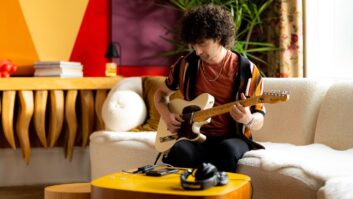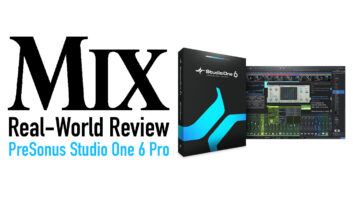Its Grand Ole image may keep outsiders from seeing Nashville as a center of technological advancement, but there’s plenty of forward thinking going on in Music City. One recent example of this is GBT Studio, the private enclave (and initials) of producer/engineer Brian Tankersley and Sawyer Brown lead singer Mark Miller. As we spoke, the final touches were being applied to their new facility, based around what Tankersley says is the “largest digital audio workstation on the planet.” And at 96 tracks, 120 analog and 60 digital inputs, it just might be.
A native of Houston, Tankersley migrated to California years ago. “I worked in L.A. for much of the ’80s, and it’s an exciting place, but in 1990 my wife and I wanted to live somewhere that was more conducive to raising our family, and we headed to Nashville.” With no experience in the country field, Tankersley needed a break, and he caught one when his friend Scott Hendricks asked him to execute the dance remix of “Boot Scootin’ Boogie,” by the then-little-known duo Brooks & Dunn. “That record went through the roof, and the album with the original version of the track sold more than 5 million units. Our mix became so popular that it was included as a bonus cut on their second CD. I was very fortunate to work on ‘Boot Scootin’ Boogie,’ because it put me front and center as a country mixer.”
During the past two decades, Tankersley has worked on nearly every major console and tape system on the market. But in place of a traditional board and either analog or digital tape recorders, GBT Studio sports a huge E-mu/Ensoniq PARIS workstation.
“Back in November of ’97, I was exposed to the then-brand-new PARIS system,” Tankersley recalls. “It used an early software revision, and I wasn’t convinced it could be integrated into a professional scenario. About a year later, PARIS had developed to the point where it could do what I needed to make records. I purchased PARIS expecting to use it as a utility device, principally for vocal comping, but I was shocked at how good it sounded, and sound is everything to me.” During the past year, Tankersley has been co-producer/engineer/mixer on Lone- star’s Number One single “Amazed,” which was mixed in PARIS, and Newsong’s Number One hit “Can’t Keep a Good Man Down,” which was done entirely within the system.
Disk-based delivery formats can be a thorny issue when you store mixes on a workstation that’s not ubiquitous. When he began executing final mixes in PARIS, Tankersley often carted a pared-down system to a local mastering room, and he’s toyed with the idea of leaving one in such a facility on a semipermanent basis. Currently, 24-bit masters are delivered on Tascam DA-45HR DATs. “I’d rather cut out going from the computer to tape-any device that involves a physical tape transport brings its own internal and external clocking issues into the process,” Tankersley explains. “So far, we’ve suffered no problems dropping to 24-bit DATs, but why introduce another variable? If I can go directly from my DAW into their system, I bypass any jitter that might be caused by a DAT transport, for example.”
Ratcheting up his personal studio became the only way to go when Tankersley found that more and more of his clients were asking to track as well as mix on PARIS. Among them was Sawyer Brown’s lead singer Mark Miller. After snagging the Grand Prize on the Star Search television program-and the $100,000 that went with it-Sawyer Brown was signed by Curb Records. They’ve turned out 17 albums for the label, with hits that include “Some Girls Do,” “The Race Is On” and “The Walk.” Due out this summer is the band’s latest CD, Sawyer Brown Live, produced by Miller and Tankersley.
“Brian handled a couple of dance mixes for us, and I was blown away by the sound, so I came over to his place and I was amazed at the speed at which he was trying out different ideas working on PARIS,” says Miller, who has his own 48-track project room with a Neve console. “I’ve also started proj-ects in my place and thrown them into PARIS, and there’s absolutely no sound coloration added. It sounds like great analog technology.”
GBT Studio blends a traditional approach with new technology. “We decided to build a large control room, one that could handle as many people as was humanly possible: Ours is a 20×30-foot space. Inside are three separate workstations, each acoustically treated on three sides with acoustic foam for absorption. Players at these stations face the console, and they have the option of putting on headphones if they want to. On the other hand, we have a pair of boom stands hanging upside down approximately 12 to 18 inches from their face, and a subwoofer in the back of their chair in case a player wants to monitor without using phones.
“Why have a bunch of iso booths when half of them are used for guitars and Leslies?” he continues. “We built three iso booths that aren’t visually accessible from the control room, designed to have an acoustical space for a guitar cabinet, live drums, or some other high-SPL piece of equipment [rather than a guitar that might be tracked directly to PARIS, for example], which would bleed too extensively to be appropriate for the control room. Fundamentally, though, we’re going to have players in the room with us for most of the tracking, to maximize the human interaction. We’ll be able to sit there and get a vibe going, while we’re tracking directly to DAW.”
PARIS also offered other amenities to Tankersley. “I demand a discrete fader per track, just like I’d have on an analog board,” he explains. “I use four 24-inch Sony monitors. Together, these let me look at 64-channel strips at a width onscreen that compares with what you’d see if you were using a Neve VR.” Additionally, the recording system runs on a single PC with a fast 1GHz Athlon processor offering ample native processing power. “As a test, I pulled up 59 Waves Renaissance EQ modules and applied them randomly to tracks,” Tankersley notes, adding that he typically buses signals in and out of his computer, eschewing the logic that says all functionality must reside inside one box. “The system has eight stereo aux sends. Nothing prevents me from using a Lexicon 480, TC M5000 or M6000, or any of the other outboard devices we own.”
Tankersley does, however, have a PARIS wish list. “Grouping and linking faders within the onscreen mixer would be a big improvement, and I hope the 3.0 software that’s under development includes this, and my hat goes off to Digidesign for the way that Pro Tools 5 implements MIDI. I’m sure that the integration of MIDI within PARIS will improve over time.”
If the idea of combining traditional methods with modern workstation technology is to work, the players will have to buy into Tankersley’s concept. How’s it going so far? “Everyone has a great time! With 96 tracks available, we often comp rhythm takes with all of us playing to a click track,” he explains. “First we’ll print a pass live, and then do several more. When we’ve covered all sections of a tune with good performances, we play back all the various passes. Everyone picks out sections of the different takes that they like best from their individual performances. I then comp an entire rhythm section on the spot. Players get further into the session headspace because they’re more involved with the creative process. Being able to yell at each other across the room and achieve a common spirit is the goal of our operation.”







